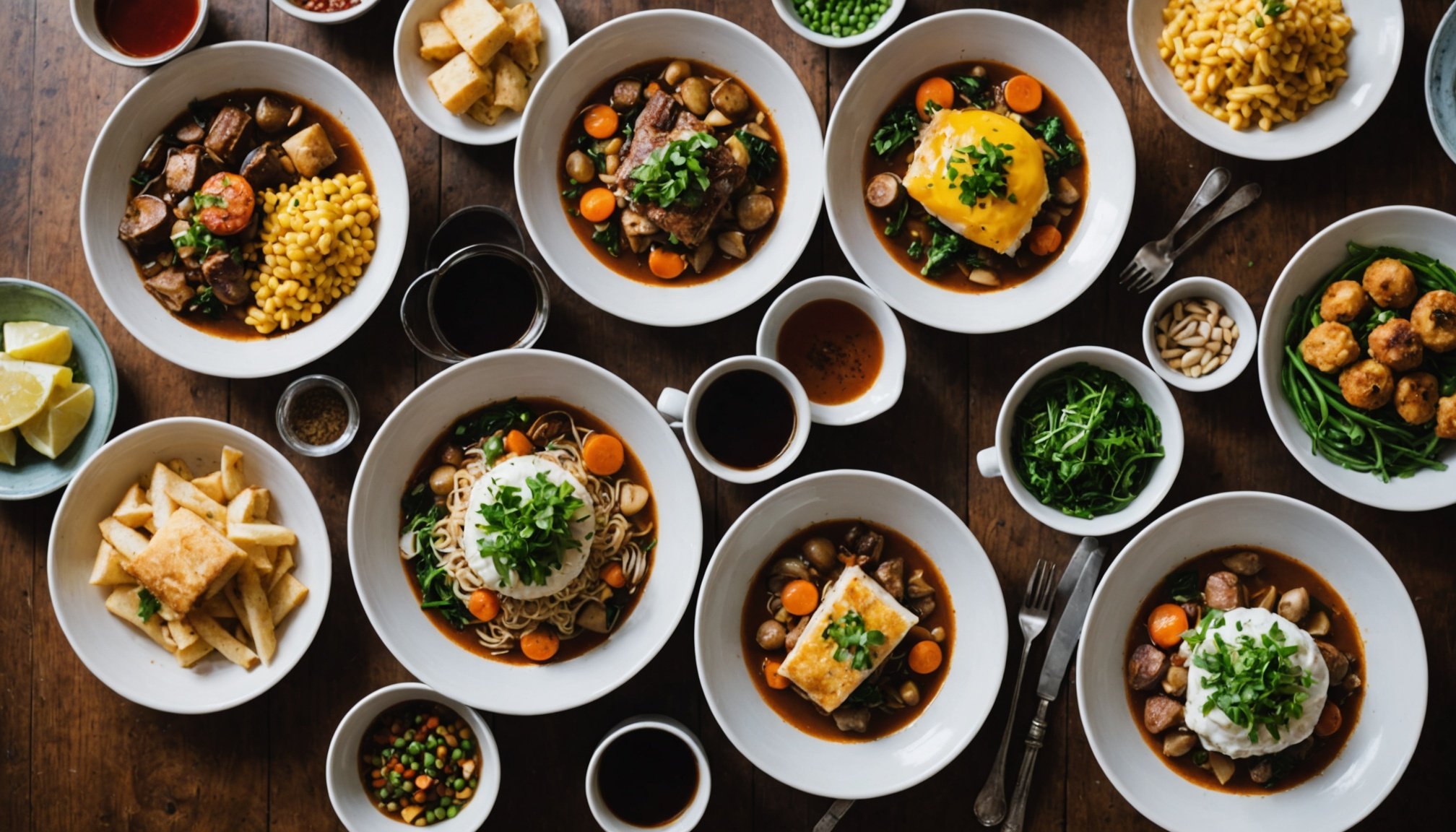Nestled on the picturesque island of Ireland lies Northern Ireland, a region renowned not only for its landscapes but also for its distinctive culinary heritage. As you traverse its beautiful cities and rustic villages, you will encounter a plethora of local dishes that capture the essence of the land and its people. Whether you are a seasoned foodie or a curious traveler, Northern Ireland offers a rich tapestry of flavors that promise a truly authentic culinary experience. This article delves into the must-try dishes that define the gastronomic scene of this enchanting region, guiding you through a journey of taste that is both diverse and delightful.
The Hearty Ulster Fry
A trip to Northern Ireland would be incomplete without indulging in the Ulster Fry, a beloved breakfast dish that has been a staple in Northern Irish homes for generations. More than just a meal, the Ulster Fry embodies the region’s ethos of warmth, hospitality, and heartiness.
In the same genre : What are the best walking trails in the Peak District for both beginners and experienced hikers?
Components of the Ulster Fry
This traditional breakfast feast typically comprises:
- Sausages: Locally sourced pork sausages that are juicy and flavorful.
- Bacon: Rashers of crispy bacon, slightly salty and perfectly cooked.
- Eggs: Usually fried to perfection with a soft, runny yolk.
- Black and White Pudding: These are types of sausage made with oatmeal, pig’s blood, and fat, offering a unique taste and texture.
- Soda Bread and Potato Farls: No Ulster Fry is complete without these quintessential breads. Soda bread is a dense, yeast-free bread with a slightly tangy flavor, while potato farls are flatbread pieces made with mashed potatoes.
Cultural Significance
The Ulster Fry is more than a mere breakfast; it represents a culinary tradition that has stood the test of time. Its ingredients have evolved to reflect the region’s rich agricultural heritage, making it a symbol of local pride.
Additional reading : How can you explore the best of London’s art scene beyond the major museums and galleries?
Often enjoyed in cozy cafes and bustling restaurants, this dish serves as a perfect introduction to the welcoming spirit of Northern Ireland. As you savor each bite, you’ll find yourself immersed in a culinary journey that connects you with the heart of the community.
Embrace the Flavors of Champ
In Northern Irish cuisine, Champ stands out as a dish rooted deeply in tradition and simplicity. It is a testament to how local ingredients can be transformed into something truly comforting.
What is Champ?
Champ is a dish primarily made up of mashed potatoes enriched with milk and butter. What sets it apart is the addition of finely chopped scallions (spring onions), which add a fresh, aromatic flavor.
Preparation and Serving
The preparation of Champ is straightforward yet requires attention to detail to achieve the perfect consistency:
- Potatoes are boiled until tender, then mashed to a smooth texture with generous amounts of butter.
- Milk is heated and infused with chopped scallions before being incorporated into the potatoes.
- Seasoned with salt and pepper, Champ is typically served as a side dish, often paired with meats or a fry-up.
Historical Context
Champ has long been a part of Northern Irish households, appreciated for its versatility and affordability. It was traditionally consumed by rural communities as a filling meal that would sustain them throughout the day.
A Modern Take
Today, Champ continues to hold its place at the dining table, both in homes and upscale restaurants. Chefs have creatively adapted it, infusing it with ingredients like cheese and herbs to elevate its profile. Yet, despite these modern twists, Champ remains a comforting reminder of the land and its people.
Savor the Richness of Irish Stew
No culinary exploration of Northern Ireland is complete without tasting the iconic Irish Stew. This dish encapsulates the essence of Irish cooking, with its emphasis on simple, wholesome ingredients that deliver profound flavor.
Ingredients and Preparation
The traditional Irish Stew is a straightforward yet deeply satisfying dish, consisting of:
- Lamb or Mutton: The meat is the star of the stew, slow-cooked to tender perfection.
- Potatoes: A staple in Irish cuisine, they add bulk and creaminess.
- Onions: Contributing both sweetness and depth.
- Carrots and Parsnips: These root vegetables offer a touch of sweetness and earthiness.
The stew is seasoned with salt and pepper, often enriched with herbs like thyme and parsley. The slow cooking process melds these flavors into a harmonious blend that is both nourishing and hearty.
Cultural Heritage
Irish Stew is more than a dish; it is a reflection of Northern Ireland’s agricultural roots and the resourcefulness of its people. It harkens back to a time when families relied on whatever ingredients were available to create satisfying meals.
Modern Interpretations
While the classic Irish Stew remains beloved, contemporary versions explore diverse flavor profiles, incorporating spices and novel ingredients. Despite these variations, the stew’s essence as a symbol of Irish warmth and resilience remains unchanged.
Whether enjoyed at a family gathering or a fine dining restaurant, Irish Stew offers a taste of tradition that speaks volumes about Northern Ireland’s culinary legacy.
The Unique Taste of Boxty
Boxty is a fascinating dish that demonstrates the ingenuity of Northern Irish cooking. This potato-based dish is a celebration of texture and flavor, offering a distinctive experience for the taste buds.
What is Boxty?
At its core, Boxty is a type of potato pancake that combines grated raw potatoes with mashed potatoes, flour, and buttermilk. The mixture is then fried or baked into flat cakes.
Variations and Serving Suggestions
Boxty comes in several variations, each reflecting the diverse culinary landscape of Northern Ireland:
- Traditional Boxty: A pan-fried version, crispy on the outside and tender inside.
- Boiled Boxty: Known as ‘boxty dumplings,’ these are boiled and served alongside hearty stews or meats.
- Baked Boxty: A loaf-like version that is sliced and enjoyed with butter or savory toppings.
Boxty is typically served as a side dish but can also stand alone as a main course, especially when paired with smoked salmon or a poached egg.
Cultural and Social Significance
Historically, Boxty was a way to utilize surplus potatoes, demonstrating the frugality and resourcefulness of Irish households. It is often associated with rural life and has been a part of festive and everyday meals alike.
A Culinary Delight
Today, Boxty has gained popularity as a versatile dish that appeals to modern palates. Its simplicity allows chefs and home cooks to add creative twists, incorporating herbs, cheese, or even sweet ingredients. Yet, its essence as a beloved comfort food remains intact, making it a must-try dish for anyone visiting Northern Ireland.
As you journey through Northern Ireland, each local dish offers a story, a connection to the land and its people. From the hearty Ulster Fry to the comforting Champ, each bite is an exploration of flavors and traditions that have shaped the region’s culinary identity. These dishes are more than just food; they are cultural touchstones, reflecting the resilience, creativity, and warmth of the Northern Irish spirit.
By embracing these local specialties, you gain a deeper appreciation for the region’s rich heritage and its ongoing culinary evolution. Whether you are sampling these dishes in bustling cities or quaint rural settings, you will discover that Northern Ireland’s food is a gateway to its heart and soul, inviting you to enjoy a truly authentic culinary experience. So, as you plan your visit, be sure to savor these delectable offerings and immerse yourself in the unique flavors that Northern Ireland has to offer.











